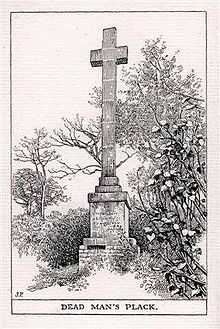Dead Man's Plack
| Dead Man's Plack | |
|---|---|
 Illustration from Dead Man's Plack and an Old Thorn by William Henry Hudson | |
| Coordinates | 51°12′04″N 1°25′39″W / 51.2012°N 1.4275°WCoordinates: 51°12′04″N 1°25′39″W / 51.2012°N 1.4275°W |
| Location | Longparish, Hampshire, England |
| Type | Cross |
| Material | Stone |
| Completion date | 1825 |
| Dedicated to | Earl Athelwold of Wherwell |

Dead Man's Plack is a Grade-II listed 19th-century monument[1] to Earl Athelwold of Wherwell,[2] who was allegedly killed near the site where it stands by his rival in love, King Edgar, 'Edgar the Peaceful', in 963.[1][2]
Description
The monument was erected at Longparish, Hampshire in 1825 by Lt. Col. William Iremonger.[1] It is a stone cross on a pedestal with plain unmoulded details.[1] An inscription on the north side of the monument describes the circumstances of Athelwold's death,[1] which occurred after Athelwold advised the king against marrying the beautiful Elfrida, but then married her himself.[2]
Edward Augustus Freeman debunks the Æthelwald murder story as a "tissue of romance" in his 1875 Historic Essays,[3] but his arguments were in turn scathingly refuted by the naturalist William Henry Hudson in his 1920 book Dead Man's Plack and an Old Thorn,[4] in which he also wrote:
One summer day, prowling in an extensive oak wood, in Hampshire, known as Harewood Forest… Eventually I came to prefer one spot for my midday rest in the central part of the wood, where a stone cross, slender, beautifully proportioned and about eighteen feet high, had been erected some seventy or eighty years before by the lord of the manor. On one side of the great stone block on which the cross stood there was an inscription which told that it was placed there to mark the spot known from of old as Dead Man's Plack; that, according to tradition, handed from father to son, it was just here that King Edgar slew his friend and favourite Earl Athelwold, when hunting in the forest.
[…]
It was not the tradition of the Saxon king nor the beauty of the cross in that green wilderness which drew me daily to the spot, but its solitariness and the little open space where I could sit in the shade and have my rest.
References
- ↑ 1.0 1.1 1.2 1.3 1.4 "Deadman's Plack Monument - Longparish - Hampshire - England". British Listed Buildings. Retrieved 8 September 2011.
- ↑ 2.0 2.1 2.2 "Test Way long distance walk". Hampshire County Council. 2011-07-01. Retrieved 8 September 2011.
- ↑ Freeman, Edward Augustus (1875). Historic Essays. MacMillan & Co. pp. 10–25.
- ↑ Hudson, William Henry (1920). Dead Man's Plack and an Old Thorn.